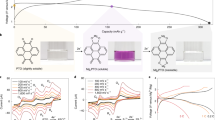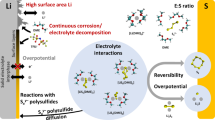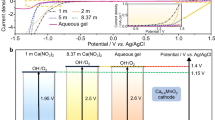Abstract
The thermodynamic properties of magnesium make it a natural choice for use as an anode material in rechargeable batteries, because it may provide a considerably higher energy density than the commonly used lead–acid and nickel–cadmium systems. Moreover, in contrast to lead and cadmium, magnesium is inexpensive, environmentally friendly and safe to handle. But the development of Mg batteries has been hindered by two problems. First, owing to the chemical activity of Mg, only solutions that neither donate nor accept protons are suitable as electrolytes; but most of these solutions allow the growth of passivating surface films, which inhibit any electrochemical reaction1,2,3. Second, the choice of cathode materials has been limited by the difficulty of intercalating Mg ions in many hosts4. Following previous studies of the electrochemistry of Mg electrodes in various non-aqueous solutions1,5, and of a variety of intercalation electrodes6,7, we have now developed rechargeable Mg battery systems that show promise for applications. The systems comprise electrolyte solutions based on Mg organohaloaluminate salts, and MgxMo3S4 cathodes, into which Mg ions can be intercalated reversibly, and with relatively fast kinetics. We expect that further improvements in the energy density will make these batteries a viable alternative to existing systems.
This is a preview of subscription content, access via your institution
Access options
Subscribe to this journal
Receive 51 print issues and online access
$199.00 per year
only $3.90 per issue
Buy this article
- Purchase on Springer Link
- Instant access to full article PDF
Prices may be subject to local taxes which are calculated during checkout




Similar content being viewed by others
References
Lu, Z., Schechter, A., Moshkovich, M. & Aurbach, D. On the electroanalytical behavior of magnesium in a polar aprotic electrolyte solution. J. Electroanal. Chem. 466, 203 –217 (1999).
Gendler, J. D. & Pletcher, D. Studies using microelectrodes of the Mg(++)/Mg couple in tetrahydrofurane and propylene carbonate. J. Electroanal. Chem. 199, 93– 100 (1986).
Brown, O. R. & McIntyre, R. The magnesium and magnesium amalgam electrodes in aprotic organic solvents. A kinetic study. Electrochim. Acta 30, 627–633 ( 1985).
Novak, P., Tuhof, R. & Haas, O. Magnesium insertion electrodes of rechargeable nonaqueous batteries. A competitive alternative to lithium? Electrochim. Acta 45, 351–367 (1999).
Aurbach, D., Moshkovich, M., Schechter, A. & Turgeman, R. The study of magnesium deposition and dissolution processes in ethereal Grignard salt solution using simultaneous EQCM-EIS and in situ FTIR spectroscopic measurements. Electrochem. Solid State Lett. 3, 31–34 (2000).
Aurbach, D. et al. Common electroanalytical behavior of Li intercalation processes into graphite and transition metal oxides. J. Electrochem. Soc. 145, 3024–3034 ( 1998).
Aurbach, D. et al. New insights into the interactions between electrode materials and electrolyte solutions for advanced nonaqueous batteries. J. Power Sources 81–82, 95–111 (1999).
Connor, J. H., Reid, W. E. & Wood, G. B. Electrodeposition of metals from organic solutions: electrodeposition of magnesium and magnesium alloys. J. Electrochem. Soc. 104, 38–41 ( 1957).
Liebenow, C. Reversibility of electrochemical magnesium deposition from Grignard salt solutions. J. Appl. Chem. 27, 221– 225 (1997).
Gregory, T., Hoffman, R. & Winterton, R. Nonaqueous electrochemistry of magnesium. Application to energy storage. J. Electrochem. Soc. 137, 775–780 (1990).
Blomgren, J. in Nonaqueous Electrochemistry Ch. 2 (ed. Aurbach, D.) 53– 79 (Dekker, New York, 1999).
Aurbach, D. & Moshkovich, M. The study of Li deposition-dissolution processes in a few selected electrolyte solutions by electrochemical quartz crystal microbalance (EQCM). J. Electrochem. Soc. 145 , 2629–2639 (1998).
Aurbach, D., Goren, E. & Chusid, O. The application of in situ FTIR spectroscopy to the study of surface films formed on lithium and noble metal at low potentials in Li battery electrolytes. J. Electrochem. Soc. 138, L6–L9 (1991).
Aurbach, D., Weissman, I., Schechter, A. & Cohen, H. XPS studies of Li surfaces prepared in several important electrolyte solutions. A comparison with previous studies by FTIR spectroscopy. Langmuir 12, 3991–4007 ( 1996).
Cohen, Y. & Aurbach, D. The use of a special work station for in situ measurements of highly reactive electrochemical systems by atomic force and scanning tunneling microscopes (AFM, STM). Rev. Sci. Instrum. 70, 4668–4675 (1999).
Yvon, K. in Current Topics in Material Science Vol. 3 (ed. Kaldis, E.) 53–129 (North-Holland, Amsterdam, 1979).
Chevrel, R., Sergent, M. & Prigent, J. Sur le nouvelles phases sulfurèes ternaires du Molybdène. J. Solid State Chem. 3, 515–519 (1971).
Ritter, C., Gocke, E., Fischer, C. & Schollhorn, R. Neutron diffraction study of the crystal structure of lithium intercalated Chevrel phases. Mater. Res. Bull. 27, 1217–1225 (1992).
Linden, D. in Handbook of Batteries 2nd edn Ch. 23 (ed. Linden, D.) 23.3– 23.22 (McGraw Hill, New York, 1994).
Acknowledgements
This work was partially supported by Advance Technology Upgrading (ATU) Ltd, Israel.
Author information
Authors and Affiliations
Corresponding author
Rights and permissions
About this article
Cite this article
Aurbach, D., Lu, Z., Schechter, A. et al. Prototype systems for rechargeable magnesium batteries. Nature 407, 724–727 (2000). https://doi.org/10.1038/35037553
Received:
Accepted:
Issue Date:
DOI: https://doi.org/10.1038/35037553
This article is cited by
-
Metal electrodes for next-generation rechargeable batteries
Nature Reviews Electrical Engineering (2024)
-
Progress and perspective on rechargeable magnesium-ion batteries
Science China Chemistry (2024)
-
Roadmap for rechargeable batteries: present and beyond
Science China Chemistry (2024)
-
Lithium crystallization at solid interfaces
Nature Communications (2023)
-
Investigation of reduced lithium titanate spinel as insertion host for rechargeable batteries
Korean Journal of Chemical Engineering (2023)
Comments
By submitting a comment you agree to abide by our Terms and Community Guidelines. If you find something abusive or that does not comply with our terms or guidelines please flag it as inappropriate.



